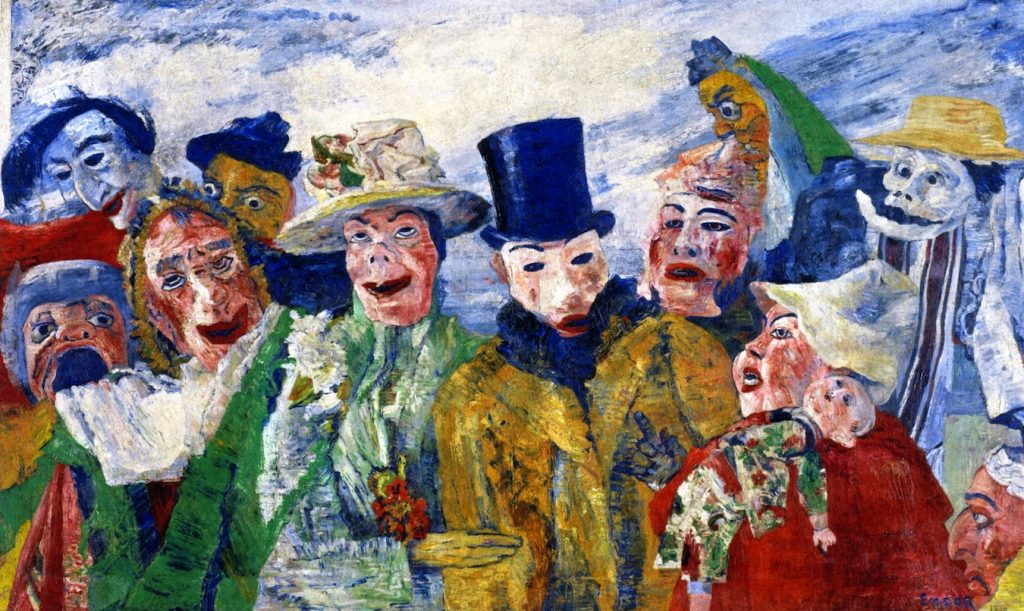The comedy of masks
07.13.2018A mask is a second frozen face that sits on the real face. It has been used for eons in ritual and sacred traditions, in theatres and for parody. A mask uses an image to convey a constrained expression, an unnatural affectation, hence social hypocrisy.
The Intrigue is a painting by James Ensor, depicting grotesque figures with masks or whose coarse expressions are reminiscent of those caricatured in masks. Truth and falsehood merge because the artifice of imposture expresses more truth than the real, inauthentic faces of the protagonists.
It has been suggested that Ensor was painting his view of his sister’s wedding to a Chinese-German art dealer. The tapered eyes of the groom in his top hat nod to his origins but more than that, his whole character evokes that of the “Saturday Baron” peculiar to the voodoo pantheon, also masked, and as expressionless as it is freakish. It may well be that the groom is trapped and has been duped by his mates. Because he is surrounded by a carnival of masks, some from the traditional fairs in European countries, others from Noh theatre (on the left, mouth wide open, swallowing the bride’s train or the character brandished in profile on the right as death wearing a festive straw hat).
Masks, a disarticulated puppet, a skull and a skeleton (often combined) are all very strange but tell the hidden truth of this wedding party behind the joy of the facade: these masks distort and make fun of their narrow views, their ridiculous affectation, their cruelty and hideousness. The painter unmasks them by showing off their masks they have donned. He denounces their true faces which are only masks borrowed from the rules and etiquette of their social milieu. The masks are the stagnant features of individuals stuffed in their roles.
A social mask is not reprehensible within itself. It is a necessary thing, often beneficial. Moreover, the very nature of each one has its own different traits, and nothing is expressed authentically without a little bit of fun and unwitting staging. The mask does not always pretend but it can help with a certain spontaneity.
The terror that James Ensor generates is that of a being who is nothing more than his mask, who cannot distinguish between his role in society and his inner life. The danger is that there is no face beneath the mask… Because “most of our work is a farce” (most of our functions and occupations are acting in other words) wrote Michel de Montaigne (1533-1592), quoting Petronius: “The whole world is acting.” He continued: “From the mask and the appearance one must not derive any real essence, nor something personal from the strangeness. We don’t know how to distinguish the shirt from the skin underneath. It is enough just to powder one’s face without powdering one’s chest in the process [the custom was to use make-up and the philosopher is giving a warning not to disguise one’s heart]. I see some people transformed and transubstantiated in so many new characters and new people that they have taken on.” (Essay, De Mesnager sa volonté) Montaigne writes about his role as mayor of the town of, adding a few lines further on: “The Mayor and Montaigne have always been two people, with a clear separation between the two.”
The painter James Ensor (1860-1949) came from a family of small traders in Ostend. Their shop sold carnival masks and a lot of strange things. The town’s carnival had made a mark on him as a child. The carnival on the eve of Lent prepared for the commemoration of the death of Christ, whom the artist saw as a harbinger of truth in a society paralysed by lies. These masks with their realistic, satirical or exaggerated appearances are anchored in the history of Belgian art going back to Hieronymus Bosch (~1440-1516).
“Ensor’s arrival in the kingdom of masks, in which he became King, happened slowly, subconsiously but within a firm rationale.” (Emile Verhaeren) His masks portray a truth, revealing how the artist subjectively sees his contemporaries. James Ensor was the precursor of Expressionism, Surrealism and Fauvism.


